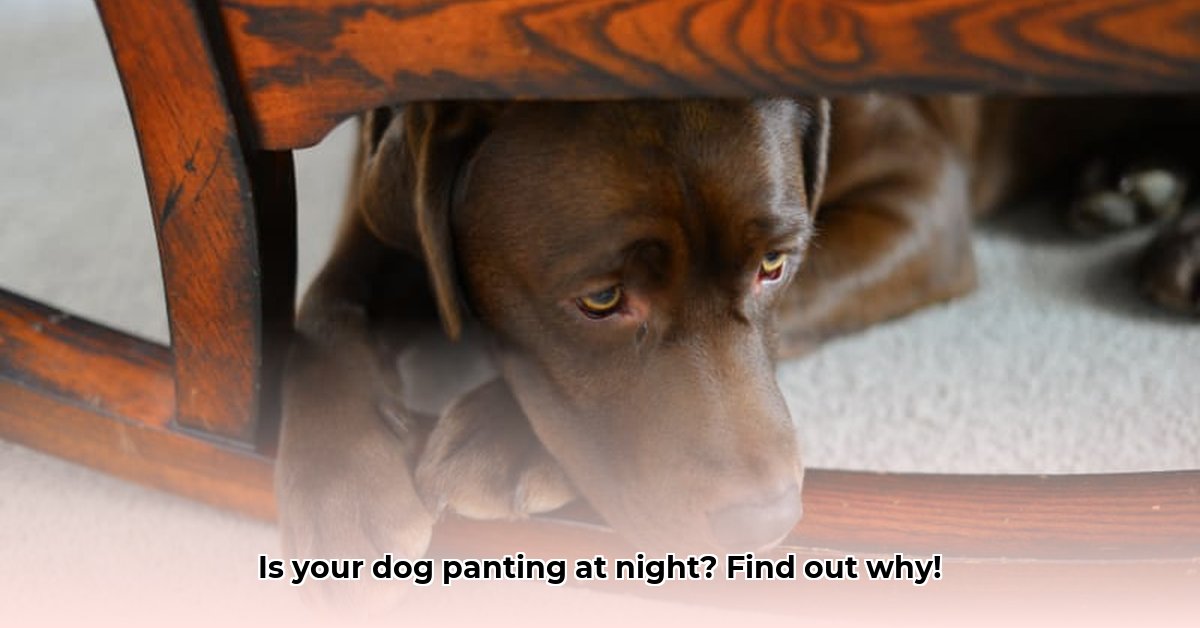Does your dog’s nighttime panting have you tossing and turning? It’s a common worry for pet owners, but understanding why it happens is key to helping your pup. For instance, trembling back legs can also indicate underlying health problems; see this helpful guide for more information. This guide will walk you through the different reasons dogs pant at night, from simple things like a warm room to more serious health problems. We’ll show you how to figure out what’s going on, offer some helpful tips for home, and most importantly, tell you when a vet visit is a must. We’ll help you tell the difference between normal panting and something that needs attention, so you can keep your furry friend happy and healthy. Let’s get to the bottom of this and give you the peace of mind you deserve.
Dog Panting at Night: Unraveling the Mystery
Is your dog’s nighttime breathing keeping you up at night? Many dog owners worry about their furry friends panting at night, and it’s understandable! Let’s explore why dogs pant at night and when you should seek professional veterinary help. This isn’t just about addressing the panting itself; it’s about understanding your dog’s overall health and well-being, thinking about the underlying cause of the dog exhibiting excessive panting. Panting is a natural cooling mechanism for dogs, similar to sweating in humans. However, excessive or unusual panting, especially at night, often raises concerns for pet owners. Understanding the potential causes of nighttime panting is crucial for assessing your dog’s health and determining the appropriate course of action.
Common Reasons Your Dog Might Be Panting at Night
There are numerous reasons why your canine companion might be breathing heavily at night. Sometimes it’s a simple fix, while other times it points to a more serious health concern. Understanding the causes of panting can help you understand if your dog is in distress or discomfort.
- Temperature Troubles: Even on a seemingly cool night, your dog might overheat. Dogs don’t sweat like humans, relying primarily on panting to regulate their body temperature. High humidity can also inhibit their ability to cool down efficiently. Think about your dog’s sleeping arrangement. Is their bed in a stuffy room? Make sure they have good ventilation and consider a cooling mat, especially for dogs with short snouts (brachycephalic breeds) or thick coats. They might also benefit from a cool tile floor to lie on. A comfortable ambient temperature for sleeping is essential.
- Pain and Discomfort: Is your dog stiff or limping? Pain from arthritis, injuries, dental issues, or other aches can cause them to pant. The discomfort elevates their heart rate and respiratory rate, leading to panting. Pain often manifests in subtle ways, so pay close attention to how your dog moves and behaves. Do they seem reluctant to get up or lie down? Are they guarding a particular area of their body? Subtle changes in posture or appetite can also be indicators of pain.
- Anxiety and Stress: Just like humans, dogs experience stress and anxiety. Nighttime can be particularly challenging for dogs with separation anxiety or fears of the dark. Loud noises, thunderstorms, fireworks, or even unfamiliar sounds can also trigger panting. A change in routine, a new pet in the house, or even rearranging furniture can cause anxiety in some dogs. Consider if there have been recent changes in their environment or routine. Look for other signs of anxiety like pacing, whining, or trembling.
- Underlying Health Issues: This is where things get a little more serious. Conditions like heart disease (leading to fluid buildup in the lungs), Cushing’s disease (a hormonal disorder causing increased cortisol levels), respiratory problems (such as pneumonia or laryngeal paralysis), anemia, and other illnesses can cause excessive panting. Senior dogs are more prone to these issues, but it can happen at any age. The panting might be a subtle sign of something else going on. Other symptoms may include coughing, lethargy, changes in appetite or thirst, and weight loss.
- Medication Side Effects: Certain medications, such as prednisone or other corticosteroids, can cause increased panting as a side effect. If your dog has recently started a new medication, discuss any potential side effects with your veterinarian.
- Senior Moments (Canine Cognitive Dysfunction, or CCD): Similar to Alzheimer’s disease in people, CCD can affect older dogs, leading to confusion, disorientation, anxiety, and increased panting and pacing at night. Other signs of CCD include changes in sleep patterns, decreased interaction with family members, and loss of learned behaviors. If your older dog was always calm at night and suddenly started panting more, CCD might be something to consider discussing with your vet.
- Bladder Issues: As dogs age, they sometimes lose bladder control and the need to urinate during the night can cause panting and restlessness.
When to Call the Vet: Recognizing the Warning Signs
While a little panting now and again is normal, persistent or excessive panting needs veterinary attention. Don’t hesitate to call for help! If your dog’s breathing feels heavy, and the panting won’t stop, call your vet. Early diagnosis and treatment are crucial for many of the underlying conditions that can cause nighttime panting.
Time to worry if you encounter these signs:
- Heavy Breathing: If the panting seems unusually labored or forceful, if your dog is struggling to breathe, or if you notice flared nostrils, that’s a red flag.
- Panting That Won’t Stop: Even in a cool environment, if your dog’s panting continues for a long time (more than 30 minutes) or seems to be getting worse, you should contact your vet.
- Other Symptoms Appear: Panting combined with coughing, lethargy (sluggishness), weakness, loss of appetite, vomiting, diarrhea, pale gums, a blue-tinged tongue, or changes in urination or defecation is a sign that something might be wrong.
- Sudden Change: A sudden increase in panting without any obvious reason (like exercise or hot weather) requires immediate attention.
- Your Gut Feeling: Trust your instincts. If something feels off, even if you can’t pinpoint exactly what it is, it’s always best to err on the side of caution and get your pet checked out. As a pet owner, you know your dog best.
A Step-by-Step Approach to Handling Nighttime Panting
Here’s a practical guide to help you navigate this situation:
- Observe and Document. Keep track of how often your dog pants, how long each episode lasts, and how hard they’re breathing. Note any other symptoms, such as coughing, restlessness, or changes in behavior. Also note the time of day the panting occurs. A simple notebook or even a notes app on your phone can be helpful.
- Check the Environment. Make sure your dog sleeps in a cool, well-ventilated area. The ideal room temperature for a dog is between 68°F and 72°F (20°C and 22°C). Ensure adequate ventilation. Fresh, cool water should always be available. Consider a fan, air conditioner, or cooling mat if needed.
- Investigate Possible Causes. Was it particularly warm last night? Did something stressful happen? Did your dog seem to be in pain? Is there any visible injury? Try to identify any potential triggers.
- Provide Comfort and Reassurance. If you suspect anxiety, try to create a calm and safe environment for your dog. A comfortable bed, a familiar toy, or gentle petting can help.
- Consult Your Vet. If the panting continues or gets worse, schedule a veterinary appointment. The more information you can provide – your observations, your dog’s history, current medications, etc. – the better they can help you.
- Follow Vet’s Instructions. Your veterinarian will likely perform a physical examination and may recommend blood tests, X-rays, or other diagnostic tests to determine the underlying cause of the panting. They will then provide guidance on managing the condition, whether it’s medication, pain management, changes to your dog’s diet, or modifications to their environment. Follow these instructions closely.
Understanding the Risks: A Helpful Guide
It’s helpful to think about the likelihood and severity of different potential causes of the problem:
| Condition | Likelihood | Severity | What You Can Do |
|---|---|---|---|
| Heatstroke | High (hot weather) | Very High | Cool environment, lots of water, immediate vet care. Prevention is key: never leave your dog in a hot car, and avoid strenuous exercise during the hottest parts of the day. |
| Heart Disease | Moderate (older dogs, certain breeds) | Very High | Regular vet checkups, proactive care, medication as prescribed by your veterinarian. A low-sodium diet may also be recommended. |
| Respiratory Problems | Moderate | High to Very High | Vet examination, possible treatment with medication or surgery, maintaining a healthy weight. Avoid exposure to smoke and other irritants. |
| Canine Cognitive Dysfunction | High (senior dogs) | Moderate | Vet care, create a calm and predictable environment, medication or supplements as prescribed by your veterinarian, mental stimulation. |
| Pain (arthritis, injuries, etc.) | Moderate | Moderate | Pain management from your vet (medication, physical therapy), comfort measures (soft bedding, supportive aids), |
- Gluten Free Meal Prep Ideas for Delicious, Hassle-Free Eating - November 28, 2025
- Gluten Free Meal Prep for Stress-Free and Healthy Eating - November 27, 2025
- Quick And Easy Chicken Thigh Meal Prep For Weight Loss - November 26, 2025










